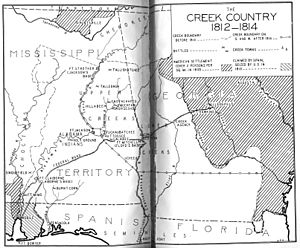Battle of Calebee Creek facts for kids
Quick facts for kids Battle of Calebee Creek |
|||||||
|---|---|---|---|---|---|---|---|
| Part of the War of 1812, the Creek War | |||||||
 Fort Mitchell (Floyd's Base) shown along the Federal Road near Autossee and Calabee |
|||||||
|
|||||||
| Belligerents | |||||||
| Red Stick Creeks | |||||||
| Commanders and leaders | |||||||
| John Floyd |
|
||||||
| Strength | |||||||
| 1300 | |||||||
| Casualties and losses | |||||||
| 25 killed, 150 wounded | 50 killed, unknown wounded | ||||||
The Battle of Calebee Creek was an important fight during the Creek War in 1814. It happened on January 27, 1814, in what is now Macon County, Alabama. This battle was part of a larger conflict called the War of 1812.
In this battle, American forces led by General John Floyd were attacked by Red Sticks, a group of Creek warriors. Even though the Red Sticks launched a surprise night attack, General Floyd's troops managed to defend their camp. However, Floyd decided to pull his forces back after the battle. This fight is also known as the Battle for Camp Defiance.
Contents
Why Did the Battle Happen?
After the Red Stick attack on Fort Mims in August 1813, the states of Georgia and Tennessee, along with the Mississippi Territory, sent soldiers to stop the Red Stick "rebellion." General John Floyd was put in charge of a group of these soldiers. He wanted to move his troops deep into Creek lands.
However, it was hard for him to get enough food and supplies for his soldiers. Despite these problems, his forces launched two attacks into Creek territory. The first attack led to the Battle of Autossee in November 1813. In that battle, Floyd's men killed many native warriors and burned a town.
After resting for two months, General Floyd, who had been hurt in the knee, led about 1,700 militia and allied Creek warriors. They traveled about 40 miles west to build supply stations. These stations, called Fort Hull and Fort Bainbridge, were built along the Federal Road.
Around the same time, General Andrew Jackson was also leading his own troops. He marched toward a Creek village to help General Floyd by distracting the Red Sticks. Jackson's forces fought in the Battles of Emuckfaw and Enotachopo Creek. Even though Jackson's troops faced tough fighting, his actions helped to draw attention away from Floyd.
The Battle Begins
Paddy Walsh and William Weatherford (also known as Red Eagle) were important Red Stick leaders. They knew General Floyd was coming and gathered about 1,800 Creek warriors. They held a meeting to decide how to fight back.
Weatherford wanted to wait for Floyd's men to cross the Calabee Creek first. He planned a surprise attack to rush the officers' tents. But this plan was seen as too risky. So, Paddy Walsh ended up leading the attack without Weatherford. Their goal was to sneak past the guards, kill as many enemy soldiers as possible, and then leave at daylight.
Early in the morning on January 27, 1814, about 1,300 Creek warriors successfully snuck past the campfires. They attacked General Floyd and his militia from three sides. They had hidden in the swamps until about 5:30 AM.
During the intense fighting, many soldiers ran out of weapons or ammunition. One artilleryman, Ezekiel M. Attaway, bravely grabbed a tool from his cannon. He shouted, "We must not give up the gun, boys. Seize the first weapon you can lay your hands upon, and stick to your post until the last." The cannon crew, who were very close to losing their important cannons, fired several grapeshots. This quick action helped to break the spirit of the attacking Creek warriors.
Another important moment came when Timpoochee Barnard rescued a group of soldiers led by Captain John H. Broadnax. This group had been cut off from the main force. Thanks to these brave actions, Floyd's forces were able to defend their camp until dawn. At that point, General Floyd ordered his men to counterattack with bayonets.
What Happened After the Battle?
The fighting lasted for about an hour. After the battle, General Floyd marched his forces back to Fort Hull, then to Fort Mitchell, and finally back to Georgia.
About 50 Red Stick warriors were killed, including a leader named Chief High Head Jim. Paddy Walsh was also seriously injured. On Floyd's side, 25 militiamen and allied Native Americans died, including Captain Samuel Butts. About 150 of Floyd's men were wounded.
Even though the Creek warriors might have lost more men, many people believed that General Floyd's side had the harder time in the battle.
After this battle, the Red Sticks gathered their forces in a strong area near the Tallapoosa River. This set the stage for the very important Battle of Horseshoe Bend, which would happen later.
Where is the Battlefield Today?
The land where the Battle of Calebee Creek took place is now private property in Macon County, Alabama. It's located where Calebee Creek meets the Tallapoosa River. Today, there are no special markers or upkeep at the site to remember the battle.

